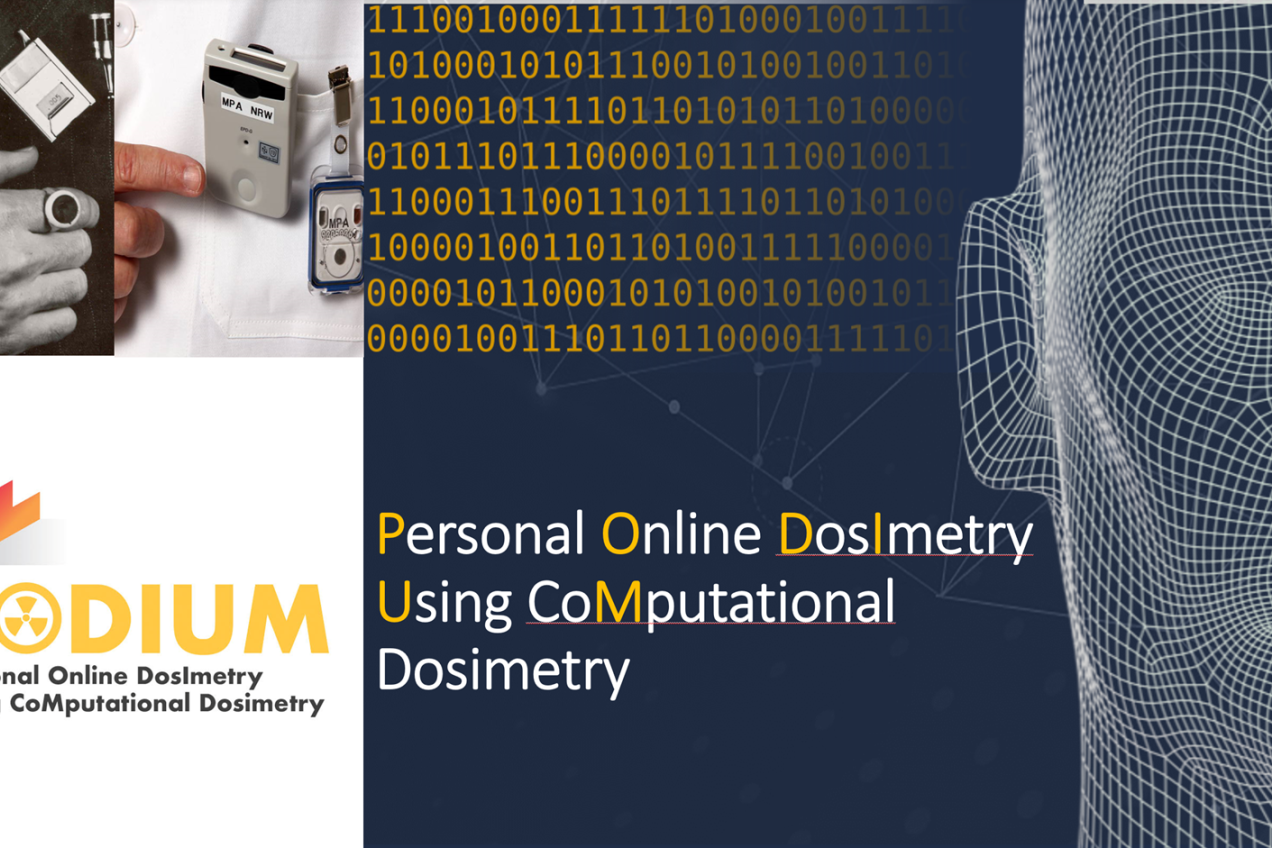15th EURADOS Webinar: PODIUM - personal online dosimetry using computational methods
All information
Online event
Starting time: 14:00 CEST
Overview
Individual monitoring of workers exposed to external ionizing radiation is essential to allow application of the ALARA principle and follow up of the official dose limits. However, large uncertainties still exist in personal dosimetry. Also, many practical problems exist for personal dosimetry, with many dosemeters getting lost and the reluctance of many workers to wear one or more dosemeters.
Most legal dosimetry is done with passive dosemeters, which are analyzed after the wearing period in an accredited lab. Active dosemeters are also widely used, although mostly only for ALARA purposes or for specific exposure situations. Although the active dosemeters are dosimetrically and technically at least equivalent to passive dosemeters, their higher cost limits their use as only legal dosemeters.
In an attempt of reinventing dosimetry by using the modern evolutions in simulations, artificial intelligence and computer vision, the PODIUM project was set up. PODIUM was a short feasibility project, funded by the EC CONCERT programme.
The objective of the PODIUM project was to improve personal dosimetry by an innovative approach: the development of an online dosimetry application based on computer simulations without the use of physical dosemeters. Operational quantities, protection quantities and radiosensitive organ doses (e.g. eye lens, brain, heart, extremities) can be calculated based on the use of modern technology such as personal tracking devices, flexible individualized phantoms and scanning of geometry set-up. When combined with fast simulation codes, the aim was to perform personal dosimetry in real-time.
We applied and validated the methodology for two situations where improvements in dosimetry are urgently needed: neutron workplaces and interventional radiology. Several validation and test measurements were done in different hospitals, and in 2 workplace fields with significant neutron exposure. Personal doses could be calculated within acceptable simulation times, just based on captured movements of the workers and information of the radiation fields. These doses agreed with the results from physical dosemeters within the standard uncertainties that are accepted in personal dosimetry.
This PODIUM dosimetry method can also be used to visualize the radiation in near real time. This will increase awareness of radiation protection among workers and will improve the application of the ALARA principle, and it can also be used in training modules. The use of neural networks and big data will help in further reducing simulation time, making real time simulations and dosimetry without physical dosemeters possible in the near future.
Programme
- Introduction of PODIUM + general set-up - Filip Vanhavere
- Fast Monte Carlo methods for interventional radiology - Maria A. Duch
- Feasibility of PODIUM in Interventional Radiology and Interventional Cardiology - Una O'Connor
- Application of the PODIUM approach in simulated and realistic workplace neutron fields - Jon Eakins
- Discussions
Registration info
Register here!
Speakers
Filip Vanhavere
Head of the radation protection dosimetry and calibration group at SCK CEN, deputy director of the Institute of Environment, Health and Safety
Filip Vanhavere is head of the radation protection dosimetry and calibration group at SCK CEN, and he is deputy director of the Institute of Environment, Health and Safety. This is institutes groups over 260 scientists, technicians and PhD students working in research on radioactive waste, decommissioning and radiation protection. Filip Vanhavere has graduated as civil engineer and nuclear engineer from Ghent University, and holds a PhD in applied sciences. He is also Professor at the Oncology Department at the KUL, in the group of Experimental Radiotherapy. He is currently chair of EURADOS, the European Radiation Dosimetry Group. He is associate editor of the Journal Radiation Measurements, and author of more than 200 publications in a wide range of international journals.
Maria A. Duch
Senior researcher and Head of the Radiological Protection Service of the Universitat Politècnica de Catalunya (UPC)
PhD in Physics, is the responsible of the UPC research group on Dosimetry, Medical Radiophysics and Environment (https://inte.upc.edu/en/research/groups/DRM). Head of the External Dosimetry Service and of the Calibration and Dosimetry Laboratory of the UPC, both accredited according ISO/IEC 17025 since 2002. Current secretary of Eurados Working Group 3 and co-author of the Eurados report “Overview of passive area dosimetry systems used in European countries”.
Main research areas include: Monte Carlo simulation of the transport of radiation and the study of the response of radiation detectors. She participated in several research projects by using both methodologies in different applications, either in enviromental dosimetry or medical applications.
Una O'Connor
Medical Physicist at St. James’s Hospital, Dublin, Ireland
MSc. Physical Sciences in Medicine (Trinity College Dublin). Una is a Radiation Protection Adviser and Medical Physics Expert with 20 years of experience working in Diagnostic Radiology and Nuclear Medicine. Member of EURADOS WG12. Una has contributed to several EC-funded projects and has research interests in the field of occupational dosimetry and staff radiation protection.
Jonathan Eakins
Physicist at the Radiation, Chemical and Environment Division (RCE) of the United Kingdom Health Security Agency (UKHSA)
Dr. Jon Eakins is a physicist working at the Radiation, Chemical and Environment Division (RCE) of the United Kingdom Health Security Agency (UKHSA). He has an MSci degree in physics from the University of Bristol, a PhD in mathematical physics from the University of Nottingham, and seventeen years’ postdoctoral research experience in the dosimetry of external ionizing radiation with a particular focus on Monte Carlo modelling techniques using the MCNP family of codes. He has published over 50 peer-reviewed papers, on topics including: passive dosemeter and active instrument design; field characterization; shielding applications; dose quantities; dosimetry of microparticles; and emergency and retrospective dosimetry. He leads task groups in EURADOS Working Group 6 (Computational Dosimetry) and Working Group 10 (Retrospective Dosimetry), and is a member of the UK Shielding Forum.
